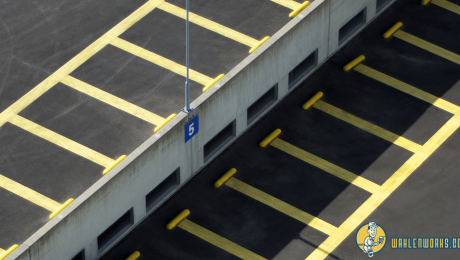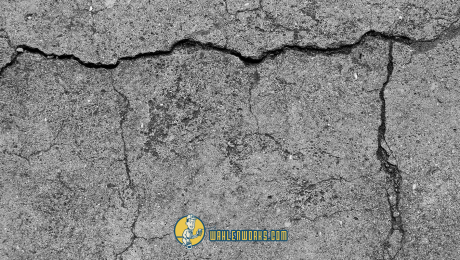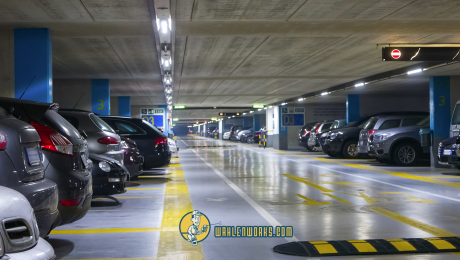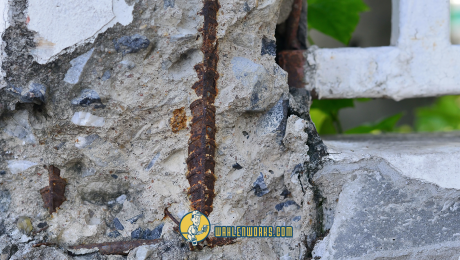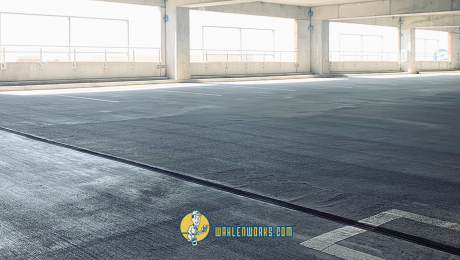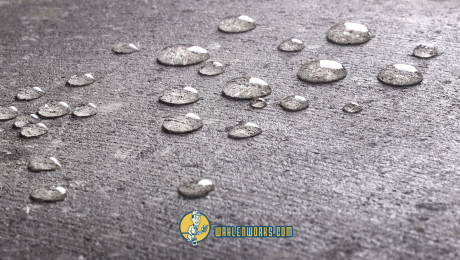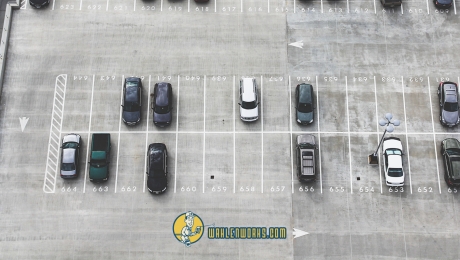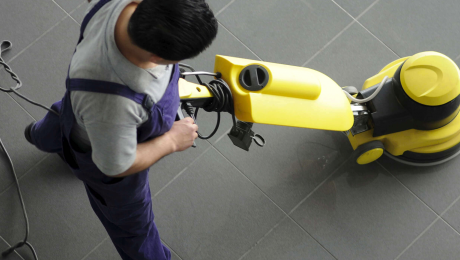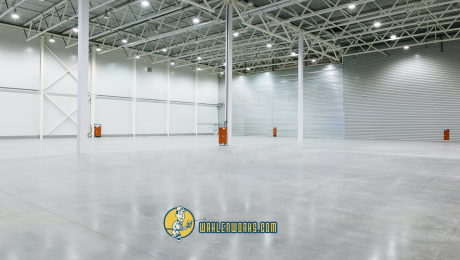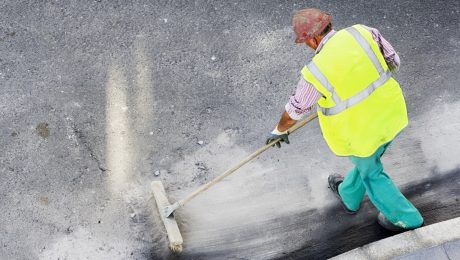Wahlen Works Blog
Parking Lot Striping for Compliance And Safety
You know your parking lot striping needs to be repainted when drivers aren’t able to see the stripes, lettering, and pavement symbols clearly enough to maneuver safely.
A good rule of thumb is that a parking lot needs to be re-striped every one to two years. If your pavement marking is just starting to fade, you might be tempted to wait another year to re-stripe, but there are good reasons not to put it off. In fact, the two most important reasons for freshly painted parking lot striping are accident prevention and ADA compliance.
“On average, more than 50,000 crashes occur in parking lots and parking garages annually, resulting in 500 or more deaths and more than 60,000 injuries.” In addition to distractions and lack of attention, “inadequate pavement striping, potholes or cracks, lack of signage, debris, poor lighting, puddles, and snow and ice also can lead to pedestrian injuries.”
In addition to the importance of providing safe parking areas, it’s a requirement that they be accessible by persons with disabilities. In 1990 the Americans with Disabilities Act (ADA) was passed and additional requirements for parking areas were added in 2010. They regulate features such as minimum number of accessible parking spaces, their location, and required signage and pavement markings.
Parking Lot Striping Q & A
Why would I need to re-stripe as often as every year? How often you need to re-stripe depends on the volume and type of traffic you get. If your parking facility is exposed to the elements and busy year-round, your parking lot striping will fade quickly. The markings on a less trafficked site, such as a school or community center, will stay bright and readable longer. The problem we often see is when facility managers decide to make their pavement markings wait another year. If a heavy rainfall prevents drivers from seeing your parking lines, you’ve waited too long to re-stripe.
How do I know if my parking facility complies with the ADA? The U.S. Department of Justice has an excellent ADA compliance brief on their website. We recommend reading it so that you’re familiar with the guidelines. Other than that you don’t need to be concerned when you hire Wahlen Works. We’re thoroughly conversant with the ADA requirements for striping, marking, and signage.
How do I maximize the safety of my parking lot? Road surface markings convey information to both pedestrians and motorists. They show pedestrians where they can walk safely and direct vehicles to where they may drive and park. Properly placed arrows, crosswalks, symbols, and signage clearly define who belongs where and who must yield to whom. It’s important to provide enough spatial margin so that 21st century distractions don’t turn into tragedy. If a driver is looking at his phone, misses a stop sign, and hits the brakes late, a little extra room can make all the difference.
What else do I need to know? It’s important to pay attention to raised embankments and changes in elevation. Painting them a contrasting color alerts pedestrians that they need to take a step up or a step down, reducing a common cause of falls.
Re-striping is a necessary part of parking lot maintenance. Vivid color contrasts and uninterrupted traffic flows direct visitor movement correctly and safely. Wahlen Works offers professional parking lot striping, pavement marking, and signage services for newly paved lots and lots that need to be re-striped. Call us today for a quote.
- Published in Marking
Wahlen Works Penetrating Sealer Extends The Life Of Your Concrete
To describe something as “weathered” is to say that it has been worn by time and exposure to the elements. A weathered house. A weathered face. Weathered concrete. Over time, everything deteriorates. You can’t completely prevent the “weathering” of your concrete, but you can slow it down significantly with a penetrating sealer.
Our 100%-solids silane sealer is a premium grade, clear, penetrating, waterproofing treatment. Silane is a combination of hydrogen and silicon and it doesn’t form a coating on the surface of the concrete like acrylics and epoxies do.
Silanes have a very small molecular structure. The small molecular size of the product enables it to penetrate deeply into the pores of the concrete but does not change the appearance or vapor permeable (breathable) nature of treated surfaces. The higher solids (100%) of our sealer compensate for its small molecular structure and low viscosity.
Silane sealer forms membranes within the surface and penetrates deeply into the concrete. This is why it does such a good job protecting the reinforcing steel. Silanes are also water-repellent and hydrophobic (having little or no affinity for water). They protect against freeze thaw damage and efflorescence. Efflorescence is the crystalline deposit of salts that form from water consisting of salt deposits left behind when the water evaporates.
The primary deteriorating agents for concrete are weather, traffic, and chemicals. A penetrating sealer is the best choice to protect concrete from chemical corrosion and freeze-thaw damage in parking garages, bridge decks, and other surfaces which are subject to extreme exposure. Our silane sealer causes concrete to become permanently repellent to water, salt, and waterborne chemicals without losing its breathability.
“Corrosion-related damage to reinforced concrete is the result of rust, a product of the corrosion process of steel, which expands and thus requires more space in the concrete than the steel did at the time of installation. This change in volume of the steel results in expansive forces, which cause cracking and spalling of the adjacent concrete. Other signs of corrosion of embedded steel include delamination of the concrete (planar separations parallel to the surface) and rust staining (often a precursor to spalling) on the concrete near the steel.”
A penetrating sealer prevents spalling, cracking, and staining longer than other concrete sealing treatments. By sealing your concrete, you’ll be spending a little now to save a lot later. It is one of the most cost-effective forms of preventative maintenance you can undertake. We have more than 40 years of experience maintaining parking facilities in Milwaukee and southeast Wisconsin We offer a 5-year warranty on our concrete sealing services so you can have confidence that your property will be protected.
- Published in Sealing
Preventative Maintenance With Concrete Sealing
In an obscure court case over an alleged breach of lease in St. Louis, the judge ruled, “to the extent defendants based their breach of lease claim on central parking’s alleged obligation to repair deterioration…to the garage’s concrete surface before the end of the lease term, the court finds in favor of defendants”.
Further down the page, discussing a different example of deterioration, one engineer said, “It’s a classic case of garage neglect, where the operator has failed to protect the decks with a sealer or coating and has allowed water to infiltrate the deck, rusting the rebar mats and (probably) the post-tensioned cables. The rust on the bottom mat steel has resulted in spalling concrete and general degradation, resulting in loss of deck strength and homogeneity.”
If you own a parking garage, preventative maintenance can save a small fortune.
One form of preventative maintenance is concrete sealing and it’s one of the best returns on investment you’ll find. Last month on this blog we wrote about chloride contamination in concrete and this month we’ll address preventing that contamination and deterioration with concrete sealing.
To prevent degradation in your concrete, you need to prevent water, salt, and waterborne chemicals from penetrating its surface. A high-quality, professional sealant blocks the pores of the concrete, preventing these damage-causing elements from working their way under the surface and attacking the rebar.
Our silane sealer is 100% solids, compared to the sealers you can buy in most home improvement stores which are about 40% solids. It’s been tested by time, having been in use now for 40 years. The small molecular size of the product enables silane to penetrate deeply into the pores of substrates but does not change the appearance or vapor permeability of treated surfaces.
In addition to parking structures, this silane sealer can be used to protect buildings, roads, balconies, plazas, and vertical surfaces. It’s approved by the USDOT for sealing bridge decks. It is quite simply, the best product you can use to protect your property. Our sealer forms a permanent chemical bond, stops freeze-thaw damage and spalling, is not susceptible to ultraviolet or chemical degradation, and is cost-effective.
Don’t neglect the preventative maintenance of your garage. A comparatively small investment now could save tens of thousands of dollars or more down the road. Our concrete sealing service also comes with a 5-year warranty, giving you confidence in the wisdom of your investment.
- Published in Parking Structures, Sealing
Chloride Contamination in Concrete Structures
We talk about chloride contamination frequently because of the damage it can do to concrete that isn’t properly maintained.
Chloride contamination comes from rock salt, the primary deicing agent used in Wisconsin. Rock salt is the mineral formed from sodium chloride. WisDOT uses an average of 526,000 tons of rock salt statewide each season. Other chloride-based deicers used less frequently are calcium chloride and magnesium chloride. All chloride deicers will initiate corrosion of the steel reinforcement if they penetrate the concrete.
Implications for Parking Garages
A major contributor to parking garage deterioration is corrosion of embedded steel. The corrosion problem is not new, but awareness of the problem has been getting more attention in recent years.
As steel corrodes it expands, causing fragments of concrete to chip away, which exposes steel further, leading to even more damage. In addition, the rebar becomes more easily breakable, which in turn reduces the garage’s structural capacity. Unfortunately, by the time the damage is discovered, the corrosion of the steel is usually quite advanced.
To put it more scientifically, “There are two consequences of the corrosion of steel. First the products of corrosion occupy a volume several times larger than the original steel so that their formation results in cracking…This makes it easier for aggressive agents to ingress towards the steel, with a consequent increase in the rate of corrosion. Second, the progress of corrosion…reduces the cross-sectional area of the steel, thus reducing its load-carrying capacity.”
Reducing Chloride Contamination
There are a number of ways to lessen concrete deterioration due to chloride contamination and reduce its influence on the service life of your facility. Some, such as adding corrosion inhibiting compounds, need to be implemented during construction. For an existing structure, protection is your best option.
In a 2018 paper published by engineers at the University of Wisconsin – Platteville, the authors recommend the use of a penetrating solution as one option. They say, “Another method to protect concrete from deicing/anti-icing chemicals is the application of topical treatments such as penetrating sealers. Penetrating sealers can seal the concrete, hence reduce the ingress of water and chemicals.”
In the spring, when the ice and snow have melted, many property owners will be greeted by the sight of blemished concrete where the surface has flaked off. As bad as that is, the unseen damage to the steel reinforcement has also likely begun and may not be noticed until it’s become expensive to repair. Before that happens, consider applying a waterproof barrier to your concrete structure.
- Published in Latest, Parking Structures
Preventative Maintenance For Parking Structures
We’ve worked in a lot of parking structures during our 49 years in business, some as small as 5,000 sq ft and others larger than 1M sq ft. Whether yours is a parking garage, a parking ramp, or a parking lot; it is a significant part of your real estate portfolio and requires both routine and preventative maintenance to maintain its value.
As an owner or manager of a parking structure, you’re well acquainted with the damage that naturally occurs over time. Potholes, cracks in the concrete, and corrosion are bound to appear: but their presence can be minimized, and sometimes almost eliminated, with regularly scheduled maintenance.
Your parking structure is the workhorse of your business and often the first point of welcome for you customers. It experiences direct exposure to vehicle traffic, weather, chemicals, and grease on a daily basis. It only takes a few missed deep-cleans for minor deterioration to start. These can turn into problems beneath the surface of the concrete before you know it.
An effective maintenance plan should include all the periodic tasks that are required for smooth day-to-day operation, as well as the tasks performed to avoid future repairs and protect the owner’s investment.
Sweeping and Washing
Your garage needs frequent sweeping — at least monthly — and quarterly pressure washing to remove sand, dirt, and other substances that wear down its concrete surface. Because of human nature, a clean garage is more likely to stay that way because people are less likely to litter in a well-maintained environment. In addition to extending the life of the facility, a clean, well-kept garage is inviting and gives you a good reputation.
In Wisconsin, it’s especially important to schedule a pressure washing in the early spring to remove deicing products and again in the fall to remove leaves and make sure the drainage system is clear.
Pavement Marking and Signage
Your maintenance schedule should include attention paid to pavement markings and signage. Parking lot striping needs to be restored as soon as it begins to fade or wear away. Concrete walks, drives, and curb landings might need to be repainted as often as twice a year for safety purposes.
Waterproofing
The main enemies of the structural integrity of your parking structure are water penetration, chloride penetration, and freeze/thaw damage. The best way to prevent the damage is to prevent penetration into the concrete with a waterproofing barrier. Waterproofing systems that protect the concrete surface extend the life of a garage and make routine maintenance tasks easier to complete.
The ideal waterproofing system uses a calcium silicate gel to penetrate the concrete and fill cracks, pores, and capillaries; forming a subsurface barrier that can’t be peeled, chipped, or scraped away.
A regular maintenance program is critical to preserving your garage and providing excellent service to your customers. Call us to talk about a schedule that perfectly meets your needs. (414) 771-0884
- Published in Latest, Parking Structures
The Benefits of Waterproofing Your Concrete
Water is the enemy of your parking structure. It can penetrate the concrete causing costly damage to its steel reinforcement. Considering the large capital investment parking structures require, it’s worth taking some time to consider how best to protect them, not only from water, but also from deicing agents and freeze/thaw cycles.
We believe that the best way to prevent concrete damage is to prevent water and chemical penetration in the first place through the use of a waterproof barrier. Membranes and silane sealant do provide some protection but have drawbacks that waterproofing does not.
For that reason, we recently partnered with Alchemco, manufacturers of the TechCrete 2500 Waterproofing system—a long-term solution that creates a waterproof barrier inside the concrete.
TechCrete 2500 offers the following benefits:
-
It has no volatile organic compounds (VOCs). VOCs are “any compound of carbon, excluding carbon monoxide, carbon dioxide, carbonic acid, metallic carbides or carbonates, and ammonium carbonate, which participates in atmospheric photochemical reactions.” In other words, emitted gases from certain solids and liquids. Because TechCrete 2500 is VOC-free, if the concrete structure is ever demolished, the concrete remains recyclable, which is good for the environment.
-
It is a penetrating solution that forms a calcium silicate gel which fills cracks and capillaries up to 2mm wide. Because it forms a subsurface barrier, it can’t be chipped or scraped away by snow plow blades and it will continue to seal future cracks up to .04mm wide.
-
There’s no need to close your parking facility during business hours in order to complete the installation.
-
One of the best features of TechCrete 2500 is its longevity. It makes the concrete surface more dense which allows it to stand up to traffic from people and cars. It also has the best warranty in the industry ranging from 15-30 years depending on the current condition of the structure.
-
A TechCrete 2500 treated surface is easy and inexpensive to maintain, requiring only regular sweeping and a yearly pressure wash.
Parking areas are a large capital investment. The longer they last, the greater the return on your investment. While the value of regular cleaning and maintenance can’t be overstated, the best protection comes from not allowing the water to penetrate the concrete in the first place. Read more about our concrete waterproofing service here.
- Published in Latest, Parking Structures
Protect Your Parking Garage: Advice From The Experts
Parking structures are expensive capital investments. In 2019, the median cost to construct a new parking garage was $21,500 per space and $64.77 per square foot. If the average garage is 145,000 square feet, then you’re looking at almost a million dollars to build a new one.
Parking structures are so common that we have become oblivious to them. Customers expect them to be there when they need them, and they expect them to be safe. Property owners need them to generate a return on investment and be well maintained. Often they will hire a facility manager to ensure that their needs and the needs of their customers are met.
So it’s no surprise that a 2019 CORT survey of facility managers found that profitability is their #1 concern — up from #3 in 2018. When property managers are under pressure to do more with less, routine maintenance and proactive protection become important.
With that in mind, here are some useful articles offering good advice on parking structure maintenance.
How to Protect Your Parking Structure from Winter Weather Damage by Sarah Kloepple, Associate Editor at Buildings.com. 5 min read.
The biggest winter weather liabilities are slip-and-fall injuries, damaging deicers, improper snow removal, and clogged drains. Having your garage professionally cleaned at least once a month will minimize the risk of injuries and chemicals and ensure that your drains don’t get clogged. Pay attention to how your snow removal company does their job to ensure that they aren’t piling the snow too high or causing damage with the snow plow blades.
Protecting Parking Structures by James P. Donnelly, P.E., S.E. 7 min read.
In this article James Donnelly, a structural engineer, gives a concise but thorough overview of the ways that parking garages deteriorate, the types of routine maintenance that need to be done, how to schedule inspections, and effective waterproofing strategies.
Financing Parking Garages: Q&A with Parking Consultant Gerard Giosa. 9 min read.
Although the majority of this article deals with the costs of building structured parking rather than surface parking, it also addresses budgeting for operational and maintenance costs. Giosa says, “A good number to budget for ongoing parking garage operating and maintenance expense is about $500 per space per year…It is also critical to perform routine preventative maintenance on the garage, including sealing decks and replacing caulking and joints, to avoid major structural repair bills as the garage begins to age. With a good preventative maintenance program, a parking garage can be expected to last 50 to 70 years or longer.”
Planning for parking: How strategy and technology can improve garage integration by Stan Bochniak, former Facility Manager. 7 min read.
The focus of this article, which first appeared in FMJ magazine, is parking in mixed-use developments. These developments combine retail, entertainment, offices, and residences in a walkable space. But, people often arrive at their initial destination by car, which makes parking an important part of the experience. “Since mixed-use garages are used more than traditional garages, their maintenance demands are higher. Spaces turn over more quickly, and everything from elevators to trash cans are used more frequently. Regular maintenance tasks, like sweeping and steam cleaning, have to be done more often and scheduling is a bit more challenging.”
A common theme among each of these articles is that when you plan for the regular cleaning and upkeep of your parking structures, you are making the wisest possible use of your budget. At Wahlen Works, we can provide a single service or a combination of services to help you maximize your dollars spent. Instead of tackling problems as they occur, budget for proactive, pre-scheduled approach to maintenance.
- Published in Parking Structures, Washing
Your 2020 Cleaning and Maintenance Schedule
January through March
April through June
July through September
October through December
- Published in Latest
Commercial Floor Sealing
Floor Sealing Questions
- Where is the floor located (warehouse, office building, etc.)?
- How old is the floor?
- Is it painted or intentionally stained?
- Was the concrete finished with any type of design.
- Are there accidental stains which need to be removed?
- Has the floor been sealed before? If so, how long has it been since the previous application?
- How much traffic does the floor have to bear?
- Published in Sealing
Construction Site Clean Up
- Trash and debris removal
- Concrete floor cleaning, polishing — and sealing if necessary
- Removal of oil, dirt, mineral residue, and paint from masonry
- Washing of walkways, entries, driveways, and parking areas
- Exterior building cleaning
- General pavement cleaning

